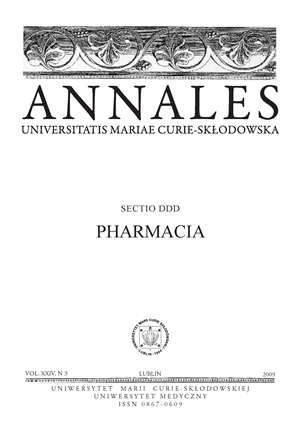Virucidal effect of Crithmum maritimum L. extracts on ECHO 9 virus
Abstract
The investigation of cytotoxic activity of methanolic extracts from the aerial parts of Crithmum maritimum L (sea fennel) was carried out on GMK cell cultures. The investigated extracts were diluted in culture media containing 2% of calf serum to the concentration of 0.025; 0.05; 0.1; 0.25; 0.5; 1; 2; 5 mg/ml. The cultures were incubated at 37ºC in the atmosphere with 5% of CO2 for 24-72 h. Cytotoxicity was determined using the colorimetric MTT (tetrazolium) method. After estimation of highest non-toxic concentration of extracts, the virucidal activity against ECHO 9 was assessed. Doses for methanolic and methanol/H2O extracts non-toxic to GMK were established at the concentrations of 2 mg/ml and 5 mg/ml, respectively. A slight virucidal effect was observed for both extracts. The methanolic extract decreased ECHO 9 replication by 1.37 log, and methanol/H2O extract by 1.14 log.
References
1. Abad M. J. et al.: Search for antiviral activity in higher plant extracts. Phytother. Res., 14, 604, 2000.
2. Apers S. et al.: Antiviral, haemolytic and molluscicidal activities of Triterpenoid saponins from Maesa lanceolata: establishment of structure-activity relationships. Planta Med., 67, 528, 2001.
3. Bermejo P. et al.: Antiviral activity of seven iridoids, three saikosaponins and one phenylpropanoid glycoside extracted from Bupleurum rigidum and Scrophularia scorodonia. Planta Med., 68, 106, 2002.
4. Cella M. et al.: Virucidal activity presence in Trichilia glabra leaves. Rev Argent Microbiol., 36, 136, 2004.
5. Cheng P. W. et al.: Bupleurum kaoi inhibits Coxsackie B virus type 1 infection of CCFS-1 cells by induction of type I interferons expression. Food Chem. Toxicol., 45, 24, 2007.
6. Chiang L. C. et al.: Cytotoxicity and anti-hepatitis B virus activities of saikosaponins from Bupleurum species. Planta Med., 69, 705, 2003.
7. Christensen L. P., Brandt K.: Bioactive polyacetylenes in food plants of the Apiaceae family: occurrence, bioactivity and analysis. J. Pharm. Biomed. Anal., 41, 683, 2006.
8. Gebre-Mariam T. et al.: Antiviral activities of some Ethiopian medicinal plants used for the treatment of dermatological disorders. J. Ethnopharmacol., 104, 182, 2006.
9. Głowniak P. et al.: Activity of Crithmum maritimum L. (Apiaceae) against Gram-positive bacteria. Ann. UMCS Sect. DDD, 19, 123, 2006.
10. Han Y. Q. et al.: In vivo and in vitro anti-hepatitis B virus activity of total phenolics from Oenanthe javanica. J. Ethnopharmacol., 118, 148, 2008.
11. Jassim S. A. A., Naji M. A.: Novel antiviral agents: a medicinal plant perspective. J. Appl. Microbiol., 95, 412, 2003.
12. Karagöz A. et al.: Antiviral activity of Sanicula europaea L. extracts on multiplication of human parainfluenza virus type 2. Phytother Res., 13, 436, 1999.
13. Khan M. T. et al.: Extracts and molecules from medicinal plants against herpes simplex viruses. Antiviral Res., 67, 107, 2005.
14. Kumarasamy Y. et al.: Screening seeds of Scottish plants for antibacterial activity. J. Ethnopharmacol., 83, 73, 2002.
15. Marongiu B. et al.: Isolation of Crithmum maritimum L. volatile oil by supercritical carbon dioxide extraction and biological assays. Nat. Prod. Res., 21, 1145, 2007.
16. Meot-Duros L., Magne Ch.: Antioxidant activity and phenol content of Crithmum maritimum L. leaves. Plant Physiol. Bioch., 47, 37, 2009.
17. Mukhtar M. et al.: Antiviral potentials of medicinal plants. Virus Research, 131, 111, 2008.
18. Müller V. et al.: Evaluation of Antiviral Activity of South American Plant Extracts Against Herpes Simplex Virus Type 1 and Rabies Virus. Phytother. Res., 21, 970, 2007.
19. Pillay D., Zambon M.: Antiviral drug resistance. BMJ, 317, 660, 1998.
20. Pillay D.: The priorities for antiviral drug resistance surveillance and research. J. Antimicrob. Chemother., 60, 57, 2007.
21. Reed L. J., Muench M. A.: A simple method of estimating fifty percent end points. Am. J. Hyg., 27, 493, 1938.
22. Ruber to G. et al.: Antioxidant and antimicrobial activity of Foeniculum vulgare and Crithmum maritimum essential oils. Planta Med., 66, 687, 2000.
23. Saxena S. K. et al.: Advances in antiviral drug discovery and development: Part I: Advancements in antiviral drug discovery. Future Virol., 60, 57, 2009.
24. Takenouchi T., Munekata E.: Amyloid beta-peptide-induced inhibition of MTT reduction in PC12h and C1300 neuroblastoma cells: effect of nitroprusside. Peptides, 19, 365, 1998.
25. Senatore F. et al.: Composition and antibacterial activity of the essential oil from Crithmum maritimum L. (Apiaceae) growing wild in Turkey. Flavour Fragr. J., 15, 186, 2000.
26. Uozaki M. et al.: Antiviral effect of octyl gallate against DNA and RNA viruses. Antiviral Res., 73, 85, 2007.
27. Wang W. N. et al.: Effect of Oenanthe javanica flavone on human and duck hepatitis B virus infection. Acta Pharmacol. Sin., 26, 587, 2005.
Downloads
Published
Issue
Section
License
Copyright (c) 2009 Authors

This work is licensed under a Creative Commons Attribution-NonCommercial-NoDerivatives 3.0 Unported License.


